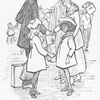Brown Nieces and Nephews in an All-White World: Gender and Genre in Dutch Children’s Novels about the Dutch East Indies, 1890-1930
DOI:
https://doi.org/10.18352/bmgn-lchr.10877Abstract
This article discusses children’s novels about Eurasian children who were sent from the Dutch East Indies to the Netherlands for the purpose of character reformation. The corpus shows a remarkable dominance of girl characters, while in actual practice it was mostly Eurasian boys who were sent away for secondary education. I explain this discrepancy between literary text and socio-historical context through the shaping influence of literary genre – that is, of the tomboy story in this particular case. This deflection largely invalidates colonial children’s novels as reliable sources of information about historical educative practices, but it makes them all the more informative regarding the attitudes and values that drove these practices. I conclude by observing that these attitudes and values were anything but homogeneous or coherent, but allowed for a certain bandwidth of variation, which undercuts stark contrasts between colonisers and colonised.Dit artikel bespreekt kinderboeken over Indo-Europese kinderen die vanuit Nederlands-Indië naar Nederland werden gestuurd met het oog op karaktervorming. Opvallend genoeg spelen meisjes het vaakst de hoofdrol in deze romans, terwijl het in werkelijkheid vooral Indo-Europese jongens waren die naar Nederland werden gestuurd voor middelbaar onderwijs. Ik verklaar deze discrepantie tussen literaire tekst en sociaal-historische context vanuit de sturende rol van literaire genre-conventies, in dit specifieke geval, van de zogenaamde ‘bakvis roman’. De dominantie van literaire genres diskwalificeert koloniale kinderliteratuur als een betrouwbare bron over historische opvoedkundige praktijken, maar het maakt ze des te informatiever waar het de houdingen en waarden betreft die ten grondslag lagen aan deze praktijken. Ik concludeer dat deze houdingen en waarden allesbehalve samenhangend of homogeen waren, maar een grote onderlinge variatie vertonen, wat het idee van een scherpe tegenstelling tussen kolonisator en gekoloniseerde ondergraaft.
Downloads

Published
Issue
Section
License
Copyright (c) 2021 BMGN - Low Countries Historical Review

This work is licensed under a Creative Commons Attribution-NonCommercial 4.0 International License.
Authors who publish with this journal agree to the following terms:
a) Authors retain copyright and grant the journal right of first publication with the work simultaneously licensed under a Creative Commons Attribution 4.0 International (CC BY 4.0) that allows others to share the work with an acknowledgement of the work's authorship and initial publication in this journal.
b) Authors are able to enter into separate, additional contractual arrangements for the non-exclusive distribution of the journal's published version of the work (e.g., post it to an institutional repository or publish it in a book), with an acknowledgement of its initial publication in this journal.
c) Authors are permitted to post their work online (e.g., in institutional repositories or on their website) prior to and during the submission process.
Authors are explicitly encouraged to deposit their published article in their institutional repository.











